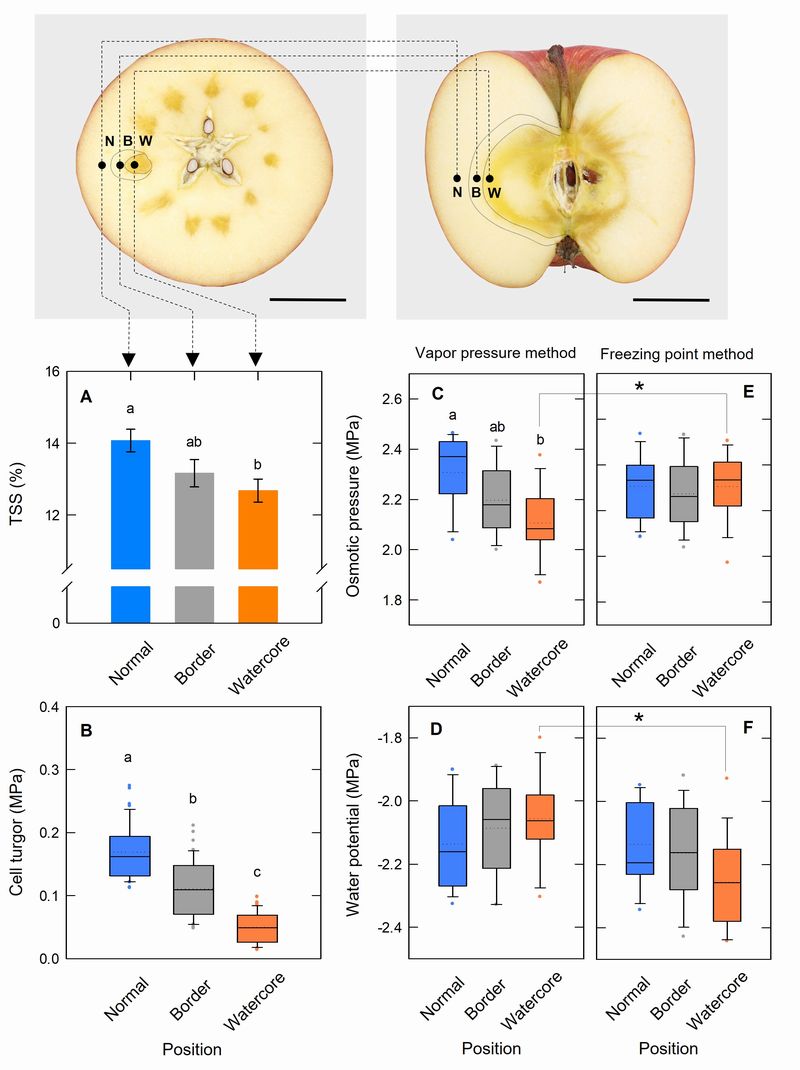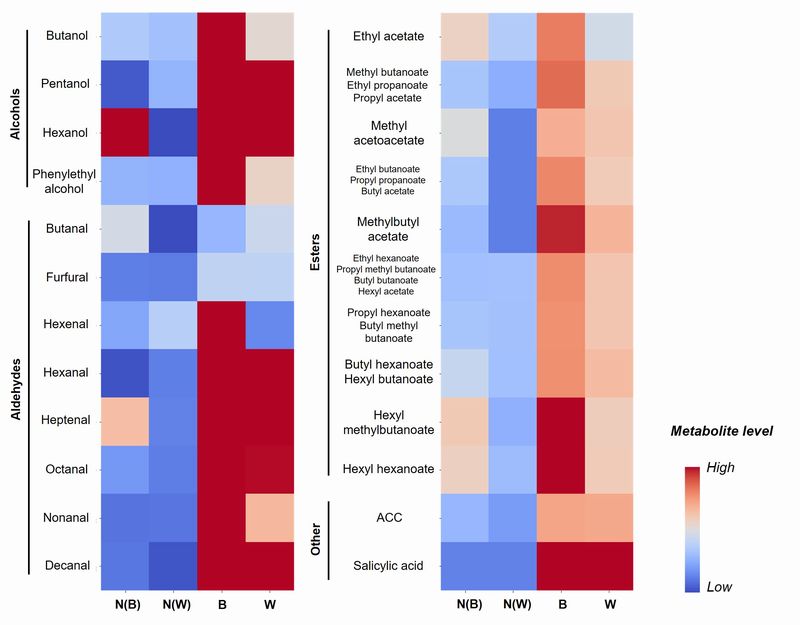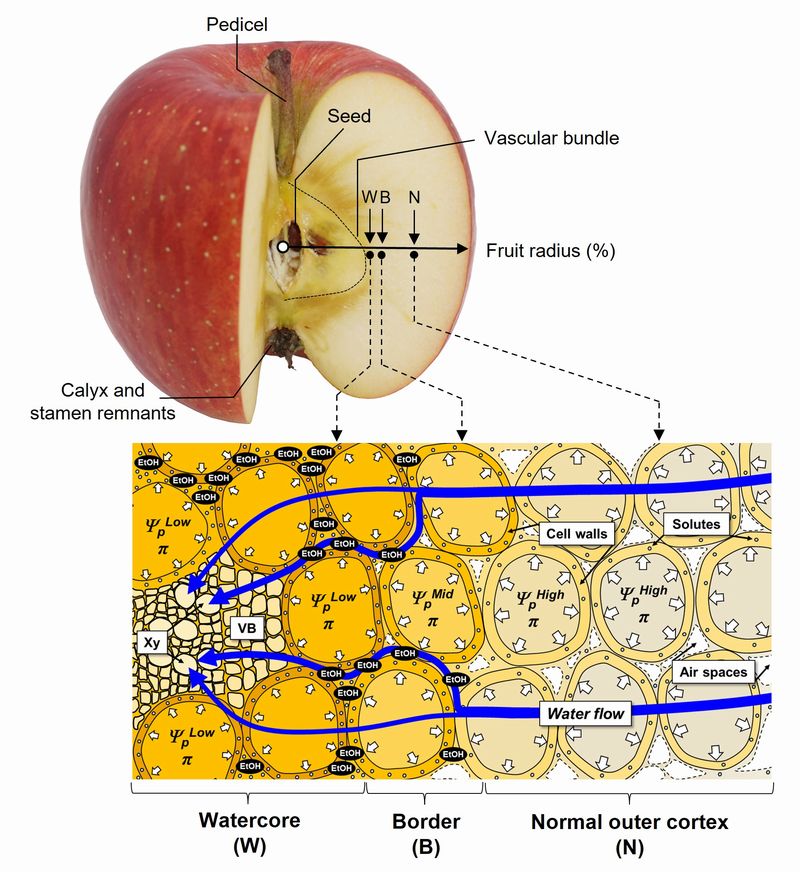Hidden mechanisms of apple watercore formation
Single cell analyses reveal hidden turgor-associated metabolic changes and water flow across the flesh in watercored apples
Watercore apples with enhanced sweet flavors are preferred in most Asian countries, although the underlying mechanisms of the transparent water-soaked symptom formation remained unknown. A collaborative research team conducted site-specific cellular analyses in conjunction with two principally different osmometers to reveal the cellular mechanisms related to the tissue appearance. This research team consists of members from Ehime University, the National Agriculture and Food Research Organization, Japan, and the University of Buenos Aires, Argentina.
Watercore is known to be a physiological disorder in Rosaceae fruits that site-specifically appears as water-soaked and translucent flesh tissue adjacent to the vascular core, which generally occurs by exposure to low temperatures after the onset of climacteric on a tree. Watercored apples, such as the popular variety ‘Fuji’, are economically of great importance in Asian fruit markets because of the marked sweet and honey rich flavor. Since increases in temperature are predicted to have an impact on the symptom formation, steady production under open field conditions is a major concern. Many studies have been conducted to investigate the physiological causes, however the exact mechanism(s) in the fruit has remained a question.
The research team utilized a novel site-specific analytical method, termed picolitre pressure-probe electrospray-ionization mass spectrometry (picoPPESI-MS, see Nakashima et al., 2016) together with two principally different osmometers (freezing point osmometer and vapor pressure osmometer) to analyze changes in cell water status and metabolisms in the following three regions: the watercore region (‘Watercore (W)’ in Figs. 1 -3), the normal outer cortex (‘Normal (N)’ in Figs. 1-3), and the border (‘Border (B)’ in Figs. 1-3, i.e., the outermost layer of watercore region) in the flesh, in both watercored and non-watercored (normal) fruit.
The analysis using picoPPESI-MS indicated that turgor-associated metabolic modifications were actively occurring in the cells at the border, inducing greater production of watercore-related volatile compounds such as alcohols and esters through fermentation, compared with other regions (Figs. 1 and 2). Furthermore, conducting the two osmometer measurements allowed identification of a significant concentration of volatile compounds generated at the watercore and border regions. Importantly, the water potential gradient that retains the potential to transport water to the watercore region from normal outer cortex was also detected in the watercore flesh, in contrast to the normal flesh (Figs. 2 and 3).
In the normal flesh, light reflection is randomly caused by the numerous air spaces present in apoplastic space (mostly intercellular air spaces), and then light is scattered and does not pass through from the cut surface to deeper tissue, causing a loss of transparency with an increase in lightness. In contrast, apoplastic spaces including air spaces in watercore flesh are filled with water, alcohols, and solutes due to the above mechanisms, resulting in an increase in transparency together with a yellowish appearance in the flesh (Fig. 3).
Reference
Nakashima et al. Single-cell metabolite profiling of stalk and glandular cells of intact trichomes with internal electrode capillary pressure probe electrospray ionization mass spectrometry. Analytical Chemistry 88, 3049-3057, doi:10.1021/acs.analchem.5b03366 (2016).
Reference URL: https://www.nature.com/articles/s41438-021-00603-1
Bibliographic Information
Direct evidence for dynamics of cell heterogeneity in watercored apples: Turgor-associated metabolic modifications and within-fruit water potential gradient unveiled by single-cell analyses. Hiroshi Wada, Keisuke Nakata, Hiroshi Nonami, Rosa Erra-Balsells, Miho Tatsuki, Yuto Hatakeyama, Fukuyo Tanaka, Horticulture Research, 8, 187, doi: 10.1038/s41438-021-00603-1, 2021 (August 3).
Fundings
- Japan Society for the Promotion of Science (JSPS) KAKENHI Grant Number 20H02982 and 19J13330
Media
-

Figure 1.
Total soluble solids (TSS) (A), cell turgor (B), osmotic pressure determined by the vapor pressure method (C), vapor pressure method-based calculated water potential (D), osmotic pressure determined by the freezing point method (E) and freezing point method-based calculated water potential (F) in each tissue in the watercored apple fruit.
In contrast with normal apples, spatial differences in cell turgor (B) as well as total soluble solids (A) have been observed in watercored apples. Using single-cell analyses coupled with two principally different osmometers show the presence of a high concentration of volatile compounds in the watercore region and a steeper water potential gradient across the flesh (F). Different letters and asterisks indicate significant differences (p<0.05).credit : Ehime University
Usage Restriction : Please contact us if you use any figures. -

Figure 2.
Comparison of metabolites level in the heatmap in each tissue located at the two regions corresponding to the border (N(B)) and watercore region (N(W)) in normal apple fruit and each tissue (border (B) and watercore (W) regions) in watercored apples.
In watercored apples, remarkable metabolic modifications through fermentation occur at the cells in the border (B) and watercore regions (W), inducing greater production of watercore-related volatile compounds, such as alcohols and esters.credit : Horticulture Research
Usage Restriction : Please use according to the Creative Commons license of Horticulture Research. -

Figure 3.
Diagram illustrating within-fruit water potential gradient associated with watercore appearance.
In the normal apple flesh, light reflection is randomly caused by the numerous air spaces present in apoplastic space (mostly intercellular air spaces), and then light is scattered and does not pass through from the cut surface to deeper tissue, causing a loss of transparency. Contrastingly in watercored apples, apoplastic spaces including air spaces in watercore flesh were filled with water, alcohols including ethanol (EtOH), and other solutes, which increases tissue transparency in addition to the yellowish appearance changes. These findings were obtained by performing picoPPESI-MS analysis combined with two principally different osmotic pressure measurements. Note that putative apoplastic solutes associated with turgor (Yp) gradient and significant water flow toward the watercore region (blue arrows) were drawn, and the solutes contained in the cells are removed to simplify. π: osmotic pressure; VB: vascular bundle; Xy: xylem; EtOH: ethanol.credit : Ehime University
Usage Restriction : Please contact us if you use any figures.
Contact Person
Name : Hiroshi Wada
Phone : +81-89-946-9824
E-mail : hwada@agr.ehime-u.ac.jp
Affiliation : Graduate School of Agriculture
